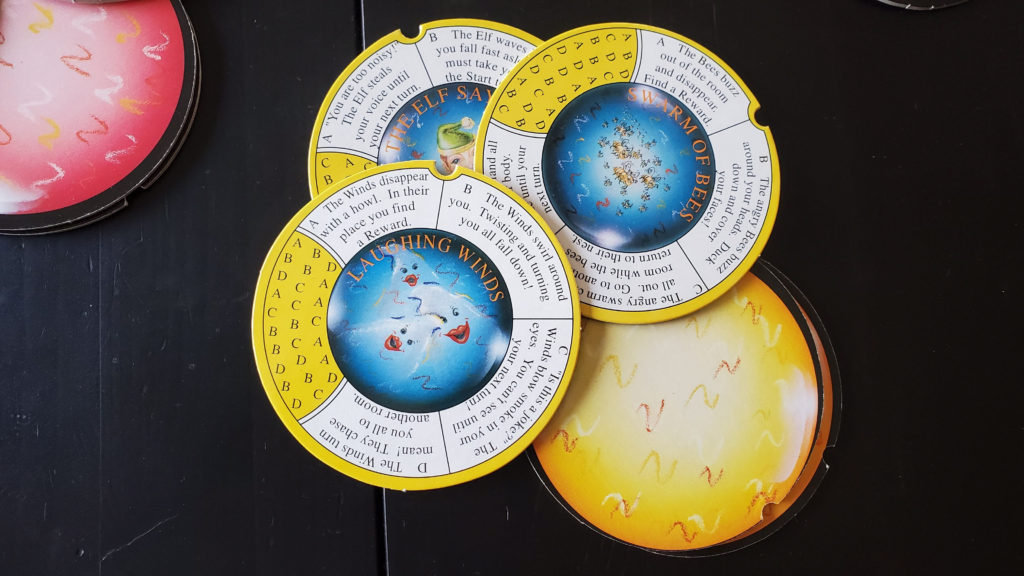I just had the chance to play a charming little game from 1992 called Jewels in the Attic, by Discovery Toys (and no other credited authors). I should also note that the same company was responsible for a series of puzzle games/activities including the Think-It-Through tiles I’ll be referencing in an upcoming post as well.
The premise is simple: The Jewelkeeper has a treasure trove of gems they have hidden in the attic of a large manor house and your group of friends have to brave the threats in various rooms using your own skills and magic items you collect along the way. Once you find enough objects to attempt the Attic, you can attempt to conquer the Jewelkeeper’s minions and defeat the Jewelkeeper himself. The trick is you play in your actual home, moving from room to room and using an ingenious set of cardboard tokens to run these challenges.
We tried it the other day with my wife and our 5-year-old. He’s into monster and fantasy stuff, but he’s never played anything much more complicated than Candy Land or the (utterly brilliant) Dragon’s Breath in terms of board games. Initial setup is picking the rooms in question for your Dark Cellar, Library, and Guest Room. Our Main Hall was the dining room table because it needs the most setup space for tokens and the Attic was played in our bedroom with space on the bed for the Jewelkeeper and his challenges.

“Character creation”, such as it is, consists of picking which blue token you will use for your abilities throughout the game. We each got two because there were so few of us, but normally it is one blue token with three abilities per token. These range from obviously useful traits (Fast Feet, Quick Hands) to handy equipment (Prybar, Flaming Torch) to downright silly (Bad Breath, Trained Fleas, Pet Mouse). Challenges are distributed among the locations on yellow disks and solved by aligning notches on your blue tool tokens to the challenge disk and reading a letter through a punched hole. This letter corresponds with one of the outcomes on the challenge and lets you know if you succeeded and got something, got run out of the room, lost equipment, etc. In theory you could eventually memorize all the win elements, but with 18 traits and 15 pieces of found gear across 15 challenges and 4 to 6 Jewelkeeper challenges which get randomized every game, it wouldn’t be easy to assume you would always get the right elements in the correct rotation for an entire game.

The challenge of the game comes in lack of information. When you come across a sleeping troll, you don’t know if fighting him or sneaking past him will work. And if you do try to sneak, is your assumption about how quiet Fast Feet or Rope the same as the game designers? We ended up attempting to bypass a pack of wolves six or seven times because we couldn’t figure out if we were supposed to befriend them, fight them, or avoid them. Similarly, a Rope seems like a good way to get to the top of a bookcase but the game disagrees. They never describe what the Blue Potion you found does, simply that it works on some challenges and not others. (My son had early success driving off a Swarm of Bees with his Bad Breath and insisted on breathing on every creature challenge as his go-to opening move. It was generally effective!) In this regard, the game is occasionally confounding but also rewards some off-the-wall thinking. It’s not King’s Quest or Escape from Monkey Island, but it mostly makes sense.
Our playthrough ended with the Jewelkeeper keeping his treasure as we had one challenge force us out of the room so many times we ran out of items to unlock the door. At that point, you can either do other challenges to secure more tools or declare the game over as you get locked out of the Attic. While initially disappointed, our kid was very vocal about liking the game the next day and wanted to go through it again. He warmed to the more physical elements like acting out the outcomes of the challenges over the course of the game (hop like a frog for a turn, shake the mouse off your foot, spin in circles and flutter your eyelids when you get conked on the head, etc.) We will be playing it again, especially as we have a lot of time with all three of us home for a few weeks…

While not a LARP or RPG per se, the opportunities a design like this could provide to the one-off mystery/escape room/LARP market is pretty huge. By aligning certain outcomes with certain inputs, you can design puzzles that have degrees of obvious outcome. The challenge disks have 4 outcomes across 26 inputs, with the challenge of opening the Attic door simply ignoring some pieces of equipment outright. By tweaking how often certain outcomes appear in the outcomes, you can tailor each event to be 10% lethal, 25 % harmful, 35% frustrating but harmless, and 30% successful. Better than a d% chart, you can even key certain elements to certain inputs, meaning a challenge later in the game can only be opened by a key item found in an earlier challenge. This one feels like underutilized technology, similar to Gloom’s transparent cards and covering or revealing certain parts of previous cards. I’m not sure how easy it would be to track down a copy of this game, but it could prove useful inspiration along these lines if you ever need it.
